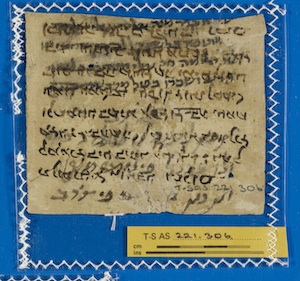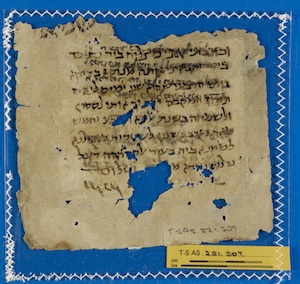A newly-discovered autograph responsum of Maimonides, lower script of a pseudo-palimpsest colophon: T-S AS 221.306–307
By Mordechai A. Friedman and Amir Ashur [1]
Upon entering the Genizah chamber, Solomon Schechter saw what he described, in an oft-quoted passage, as a battlefield (Schechter 1908: 6):
[…] Some of the belligerents have perished outright, and are literally ground to dust in the terrible struggle for space, whilst others, as if overtaken by a general crush, are squeezed into big, unshapely lumps, which even with the aid of chemical appliances can no longer be separated without serious damage to their constituents. In their present conditions these lumps sometimes afford curiously suggestive combinations; as, for instance, when you find a piece of some rationalistic work, in which the very existence of either angels or devils is denied, clinging for its life to an amulet in which these same beings (mostly the latter) are bound over to be on their good behaviour and not interfere with Miss Jair’s love for somebody […]
By the time the Conservation Department tackled the ‘unshapely lumps’ of the Taylor-Schechter Collection’s Additional Series in the 1970s, major advances had been made in the ‘chemical appliances’ and other tools of preservation; and by and large the disjecta membra were separated one from the other and laid to rest in peace. But even now one can discern signs of the fragments’ ‘clinging for their life’ or, rather, of their embrace-in-death.
An interesting example presents itself in T-S AS 221.306. At first blush, this small fragment looks like a palimpsest. A closer examination reveals that the upper script can be read only as mirror writing, while the faint, lower script has several lines written in one hand followed by several additional lines, much fainter, in another hand. These prove to be the remnants of an unknown legal query and responsum, written in Judaeo-Arabic. The address of the query and its opening lines as well as the closing line or lines of the jurisconsult's decision and his signature have not survived; but as his characteristic handwriting proves, the ruling was issued by Maimonides.
The upper script, which appears as mirror writing, is in fact the imprint left by the lifeblood of the next fragment in the folder, T-S AS 221.307. This contains the very end of a copy of some unidentified literary work and the scribe's colophon. Superimposed on this, in turn, is the imprint of the query and Maimonides’ responsum, again in what appears now as mirror script. After centuries of clinging to each other, the two fragments did not separate willingly. Some letters are preserved only in the mirror image on the matching fragment or can be deciphered more readily there than in the original. For example, in the query sent to Maimonides, in T-S AS 221.306, l. 2, nothing remains from the first two letters of אלמתופא, and only the left part of the third letter is intact (the upper layer of paper seems to be torn away here). But all three letters are clearly preserved in the mirror image on the colophon in T-S AS 221.307.
A multispectral image would probably enable better decipherment than that available now. From an examination of the original fragments and the photographic image at our disposal, little of the question and answer can be deciphered with complete certainty, and much of the text copied below is a tentative, working draft at best. The query concerns the punishment of someone who cursed and slandered another man and his late father. The questioner, evidently a local judge or community leader, seems to have not distinguished between cursing and slandering. Maimonides prescribed a lashing for the offender, if he cursed the complainant or his father. Our decipherment of the latter point is particularly uncertain, and, if correct, this ruling would appear to disagree with Maimonides’ Mishneh Tora, Sanhedrin 26:2, according to which if one curses a fellow Jew, he is liable to punishment by lashes but not if he curses a dead man. In the surviving portion of his ruling which is legible, Maimonides does not mention ‘slander’, and indeed according to Mishneh Tora, Deʿot 7:1 the slanderer is not punished by lashes.
The colophon in T-S AS 221.307 was written in Cairo and is dated ‘Wednesday, 2 Tammuz, one thousand, four five hundred and four, Era of the Documents’. It is noteworthy that the scribe instinctively wrote ‘four’ several years after the turn of the century to ‘five’. Tammuz 1504 Sel. (‘Era of the Documents’) corresponds to 1193 CE. But the calendar shows that 2 Tammuz fell on a Friday that year. In the following year, 1505 Sel., 2 Tammuz did come on a Wednesday (June 22, 1194 C.E.). Unless we assume that modern calculations of the calendar did not jibe with that followed by the Genizah people, we must conclude that the scribe mistakenly wrote not only the hundreds but also the previous unit of the year but failed to correct this error.[2] We have not seen the scribe's name, Masliah b. Nissim, elsewhere. He had a rather calligraphic hand and claimed to have proofread his manuscript and to have compared it with an accurate original. But the many errors in his colophon (including others besides the date) make one wonder how accurate his copy was.
Maimonides’ responsum was written and the literary work copied in chronological and geographical proximity, the master of law evidently working in Fustat (Old Cairo), the careless scribe in (New) Cairo. It can be assumed that both items were deposited-discarded in the Genizah at just about the same time, since in the following centuries their existence was reduced to ‘clinging one to the other for life’. Though technically separated, they defiantly stay connected until the present.
T-S AS 221.306, Maimonides’ Responsum
1 עליה ובדר מנה עליהִ וִעלי ואלדִה
2 אלמתופא בלשון קללהִ [יורינו] רבינו
3 מא ילזמה חק עלי תגריחה (?) בלשון
4 הרע ושכרו כפול מן השמים
5 אלג׳ואב
6 אן כאן לענה או לואלדה (?) ב...
7 ולו ב... פילזמה מלקות
8 ואן כאן א.... פי צ׳רב
Notes on the text
1. Cf. E. W. Lane, An Arabic-English Lexicon, Beirut 1968 [reprint], p. 166 (يبدر بادرة; بدرت منه بوادر غضب); H. Wehr, A Dictionary of Modern Written Arabic (J. M. Cowan [ed.]), Ithica 1966, p. 45 (bdr III, بادره بكلام غليظ ‘to snap rudely at s.o.’). Other phrases with מנה I בדר in Judaeo-Arabic are adduced in Friedman, Judeo-Arabic Dictionary (forthcoming).
3. Another example of ילזמה חק is found in Maimonides, Responsa (ed. Blau), vol. 2, no. 165, p. 315.
6. Laʿana lahu is not attested in the dictionaries.
Translation
1–2 […] against him and in his anger he assailed him and his late father with a curse. [Instruct us,] our master,
3 to what penalty is he liable for having defamed him (=the complainant) with
4 slander? And may he (= you) be granted a double reward by heaven.
5 The answer:
6 If he cursed him or his father (?) in […]
7 even if in […], he is liable to punishment by lashes
8 and if … he should be beaten
T-S AS 221.306 recto, Maimonides’ distinctive handwriting shines through
T-S AS 221.307, a colophon
1 שמיא
2 וכתבתי אני מצליח ביר נסים
3 בידי והגהתי אותה מנוסא בדיקא
4 ביום הרבעי (!) שהוא שני ימים לירח
5 תמוז המקבה יהפוך אותו לססון (!)
6 ולשמחה בשנת אלפא וארבע וחמש
7 מאה וארבע שנין ל[ש]טרות דרגילנא
8 למ<י>מנא ביה בעיר אלקה<א>הרה (!) דעל
9 נילוס נהרא מ[ותב]ה ושלום
Notes on the text
3. The form מנוסא is an error for מנוסחא.
5. The abbreviation המקב״ה stands for המקום ברוך הוא.
Angle brackets < > denote characters inserted above the line.
Translation
1 Heaven
2 I, Masliaḥ b. Nissim, wrote this
3 in my own hand and proofread and compared it with an accurate copy
4 on Wednesday, 2nd of the month
5 of Tammuz—may the Omnipresent blessed be He change it into a time of joy
6 and happiness—in the year one thousand, four five
7 hundred and four, Era of the Documents, which we use customarily
8 for dating, in the city of Cairo, located
9 on the Nile. Peace.
Notes on the translation
1. Heaven: this is the last word of the composition, or rather the last word of the author’s postscript.
5. Tammuz: Tammuz is a time of sadness because of the three-week period of mourning that begins on the 17th and concludes with the 9th of Av.
T-S AS 221.306 verso, the copyist’s colophon
Notes
[1] Ashur identified the fragments and recognised that the lower script of T-S AS 221.306 contains a responsum by Maimonides. The decipherment, translation and comments are by Friedman and Ashur.
[2] See Goitein (1967: 356): ‘More serious is the problem that in some cases a date in a Geniza document, mentioned together with the day of the week, differs from that calculated […]. Such baffling disagreements must be left to professional students of chronology.’
Bibliography
Blau, J., R. Moses b. Maimon. Responsa (Hebrew; 4 vols; Jerusalem, 1957–1986).
Goitein, S. D., A Mediterranean Society – The Jewish communities of the Arab World as portrayed in the documents of the Cairo Geniza, vol. 1 (Berkeley–Los Angeles, 1967).
Schechter, S., Studies in Judaism, Second Series (Philadelphia, 1908), p. 6.
Cite this article
(2012). A newly-discovered autograph responsum of Maimonides, lower script of a pseudo-palimpsest colophon: T-S AS 221.306–307. [Genizah Research Unit, May 2012]. https://doi.org/10.17863/CAM.62325
If you enjoyed this Fragment of the Month, you can find others here.
Contact us: genizah@lib.cam.ac.uk
The zoomable images are produced using Cloud Zoom, a jQueryimage zoom plugin:
Cloud Zoom, Copyright (c) 2010, R Cecco, www.professorcloud.com
Licensed under the MIT License


